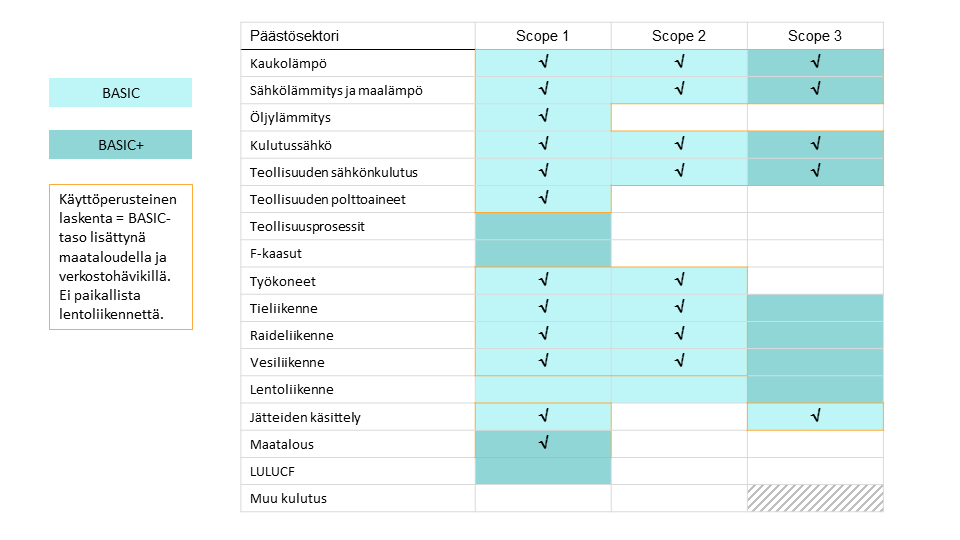Municipalities, towns, cities and other urban regions have taken on an active role in curbing climate change, setting themselves ambitious targets for reducing greenhouse gas emissions. Where do emissions originate? Have our actions made any difference? Do our neighbours do things better? These are some of the questions that can be answered with municipality-specific, regional emissions accounting, which is a key tool for climate policy.
However, the results and conclusions can vary greatly depending on the calculation method. Some clarification is therefore needed.
In this series of blogs, I will discuss different approaches to emissions accounting. I will also describe the solution currently being developed for Finnish municipalities and discuss future outlooks for emissions accounting. In this first part of the series, I will shed light on different calculation methods, the boundary conditions for calculation and international practices.
What can be included in municipal emissions?
In general, we consider a municipality to encompass all the activities taking place within its geographical boundaries. This means that climate emissions result from the activities of public administration, residents and other people doing business in the municipality as well as from the operations of companies in the area.
The simplest approach to calculating municipal climate emissions is a regional one. In this approach, municipal emissions are considered to include all the emissions generated within the geographical boundaries of the municipality, whether pouring out of a concrete chimney or being discharged in other ways. In Finland, this method is also called production-based accounting.
Consumption-based accounting, in turn, is based on the household consumption of power, goods and services, investments and consumption in public administration. The physical source of emissions plays no role in this case, and the entire production chain of goods and services is taken into account in the calculations.
The usage-based model, in which some of the elements are calculated regionally and others based on consumption, falls midway between the production-based and consumption-based approaches.
Different methods give different results
The calculation results and their comparability are influenced not only by the scope of the method (region/production/usage/consumption) but also by the choice of emissions sectors, the availability and quality of local source data and a variety of other differences in methods within individual emissions sectors.
In Finland, the usage-based calculation principle has become relatively well established due to, for example the work of the Helsinki Region Environmental Services Authority HSY, the CO2 report and the calculations that the Finnish Environment Institute has carried out for municipalities in the Hinku network. In Finland, annual emissions monitoring usually covers residential heating, power consumption, industrial fuel use, machinery, road, sea and rail transport, waste disposal and agriculture. In Oslo, for example, emissions are calculated on a regional basis, excluding agriculture, fluorinated greenhouse gases and maritime and air traffic.
As a rule, all emissions calculation models follow the IPCC methodology and the calculation principles of national emissions inventories. They usually include methane and nitrous oxide emissions, and the results are presented as carbon dioxide equivalents. Fuel emissions factors typically include only emissions from fuel combustion and do not take into account lifecycle emissions generated throughout the production chain.
In terms of carbon dioxide, biofuels are considered to be zero-emission fuels. The use of wood is reflected in the national emission balance of the land-use sector (LULUCF). As yet, LULUCF emissions have not been calculated for individual municipalities.
International practices and usage-based accounting
Regional emissions calculations and their comparability have been promoted by the GHG Protocol standard known as GPC, which was created by the WRI, C40 and ICLEI. The standard has been put to use in hundreds of cities and municipalities worldwide. The GPC standard categorises emissions into scopes: scope 1 includes direct, regional emissions, scope 2 includes emissions from grid-supplied power, and scope 3 includes indirect emissions generated outside the area but resulting from operations taking place within the boundaries of the target area.
The GPC standard offers two reporting levels, BASIC and BASIC+, which are a combination of different sectors and scopes. The following picture depicts this complex system, shedding light on the framework and its boundaries.
What in Finland has been called the usage-based calculation model corresponds to the BASIC level, expanded with agriculture and network losses (indicated as orange boxes in the figure). In other words, calculations are based on regional emissions, but the emissions from electricity and heating are calculated based on regional power consumption, while the emissions from waste treatment are based on the volume of waste produced, irrespective of where the power has been produced or where the waste treatment facilities are located. Local air traffic emissions included in the BASIC level have not been calculated in Finland.

The BASIC and BASIC+ reporting levels of the GPC standard and the framework of the usage-based calculation method employed in Finland. In the GPC standard, scope 3 for heating and electricity indicates emissions related to network loss. The upstream emissions from fuel production chains (such as oil drilling, transportation and production) are included in other consumption (other scope 3) and are therefore excluded from BASIC and BASIC+. Scope 2 for traffic indicates emissions from power consumption, while scope 3 refers to travel outside the region. In waste treatment, the waste produced by the municipality is wither treated within the region (scope 1) or outside it (scope 3). © SYKE
The state of municipal greenhouse gas emissions accounting is relatively good in Finland. Nevertheless, to improve the transparency, reliability, continuity and comparability of calculation methods as well as to promote their encouraging nature, the calculation methods must be further developed and harmonised. The goal in the future is to supplement the usage-based method with a consumption-based evaluation of emissions at the municipal level. I will discuss these in the following articles of this blog series.
Johannes Lounasheimo, Senior Specialist, Finnish Environment Institute